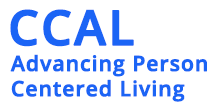CCAL was an Immense Influence on Many
CCAL advocated to make person-centered practices the standard for the way all healthcare and long-term services and supports (LTSS) are delivered to and experienced by elders and their care partners. Person-centered practices are preferable to experience and help optimize health and well-being.
Person-Centered Practices Because They Are Better
Person-centered practices (PC) are relationships that foster normalcy, choice, purpose, belonging, security & responsibility to optimize health and well-being.
Person-centered practices are BETTER because they:
- Begin with personal relationships based on dignity and respect.
- Empower each person with information and options so they can make decisions and choices that work best for them.
- Treat each person as an individual with his/her unique background, interest, preferences, routines, abilities, needs, and cultural, spiritual and ethnic practices.
- Teach care partners that everyone needs to have interesting and meaningful things to do and have purpose in daily life.
- Expand the focus from the conventional biomedical model of healthcare to a holistic one that supports well-being (emotional, spiritual, mental, and physical).
- Reflect how people want to be treated.
Person-Centered: Background
Person-centeredness emerged from humanistic psychology and the important work of Carl Rogers and Abraham Maslow. Humanism is based on the fact that people are more than physical beings. As such, care needs to be focused on them as a whole. The whole includes a psychosocial, spiritual context as well as physical. Person-centered practices move beyond the physical context and include the whole being. Person-centered practices are more pleasant to experience, help to optimize health and well-being outcomes, and result in higher satisfaction.
Depending upon the constituency, numerous terms for person-centeredness are used such as patient-centered, resident-centered, person-directed, and relationship-centered. The most commonly used term is person-centered and as such was adopted by the Person-Centered is BETTER effort.
In the United States, healthcare systems and processes were designed around efficiency and standardization. Efficiency and standardization was an effective model for the industrial age that needed to mass produce materials and equipment, however, it turned out not to be an effective design for healthcare. The Institute of Medicine (IOM) in its seminal 2001 Crossing the Quality Chasm report described healthcare in America as impersonal and fragmented. The report stated that a healthcare redesign was needed that shifted away from the traditional medical/disease-centered approach to care to a person-centered one.

